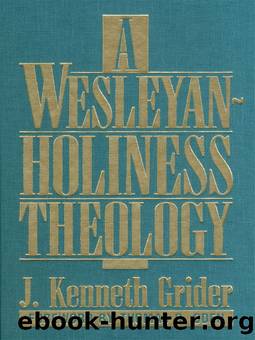A Wesleyan-Holiness Theology by Grider J. Kenneth

Author:Grider, J. Kenneth
Language: eng
Format: epub
Publisher: Beacon Hill Press
Published: 2011-01-01T00:00:00+00:00
12
The Meaning of the Atonement
The word âatonementâ translates the Hebrew Old Testament word kippur, but there is no Greek New Testament word for atonement. Hilasterion (âpropitiationâ) is sometimes translated âsacrifice of atonementâ (Rom. 3:25). Cognates of katallage, âreconciliation,â are also sometimes so rendered. The Old Testament word's basic verbal meaning is âto cover.â1 This basic meaning of the Old Testament word has suggested to many interpreters that our sins are only covered over, without righteousness being imparted to us. But the word probably means that our sins are covered over as a wound is covered when it heals and new flesh takes the place of, say, an infected cut (see Ps. 32:1; Rom. 8:4).
God Planned the Atonement. Some writers have suggested that the Cross was not plannedâthat it intruded itself into the situation, and then God made use of it. Alan Walker, for example, says that the Father âdid not intendâ the Crucifixion, but that âonce it happened ⦠God seized upon the Cross and ⦠made it the occasion of salvation.â2
Yet Scripture teaches that Christ's atoning death was in God's plan all along. It speaks of Christ as the âLamb that was slain from the creation of the worldâ (Rev. 13:8). Some seven centuries beforehand, Isaiah had foretold that Christ would suffer death on our behalf (chap. 53). And Jesus said, âFor even the Son of Man did not come to be served, but to serve, and to give his life as a ransom for manyâ (Mark 10:45; see Matt. 20:28). Christ came to earth for the purpose of giving His life on our behalf.
Blood, in Atonement. Blood is significant for the Atonement. âWithout the shedding of blood there is no forgiveness,â we read in Heb. 9:22. But Scripture says that âthe life of every creature is its bloodâ (Lev. 17:14). So we are redeemed through Christ's death because a life was givenânot because any given amount of literal blood was poured upon us. In Old Testament times the priest drew blood from animals until no life was left in themâ and with that blood made atonement for the sins of the people.3 That blood represented the life of a perfect animal given for the covering over of sinâin the sense of healing.4
Necessity of the Atonement. There are two senses in which the necessity of the Atonement can be discussed. It can be necessary either as the only way in which God could have provided for an atonement, or simply as the one way in which He did indeed provide for it.
If we say that the Atonement provided is the only kind that was open to God, we get into an evangelical rationalism. If we say this, we restrict God, questioning His sovereignty and making Him subject to certain laws of necessity, as the ancient Stoics taught.
We can say only that some kind of atonement was necessary if the holy God was to forgive and cleanse us sinful human beings. We can speak of the appropriateness of the method of atonement that He chose.
Download
This site does not store any files on its server. We only index and link to content provided by other sites. Please contact the content providers to delete copyright contents if any and email us, we'll remove relevant links or contents immediately.
The Lost Art of Listening by Michael P. Nichols(7170)
Why I Am Not A Calvinist by Dr. Peter S. Ruckman(4051)
The Rosicrucians by Christopher McIntosh(3375)
Wicca: a guide for the solitary practitioner by Scott Cunningham(3046)
Signature in the Cell: DNA and the Evidence for Intelligent Design by Stephen C. Meyer(2880)
Real Sex by Lauren F. Winner(2874)
The Holy Spirit by Billy Graham(2782)
To Light a Sacred Flame by Silver RavenWolf(2681)
The End of Faith by Sam Harris(2637)
The Gnostic Gospels by Pagels Elaine(2403)
Waking Up by Sam Harris(2334)
Nine Parts of Desire by Geraldine Brooks(2283)
Jesus by Paul Johnson(2232)
Devil, The by Almond Philip C(2207)
The God delusion by Richard Dawkins(2193)
Heavens on Earth by Michael Shermer(2191)
Kundalini by Gopi Krishna(2094)
Chosen by God by R. C. Sproul(2058)
The Nature of Consciousness by Rupert Spira(1983)
